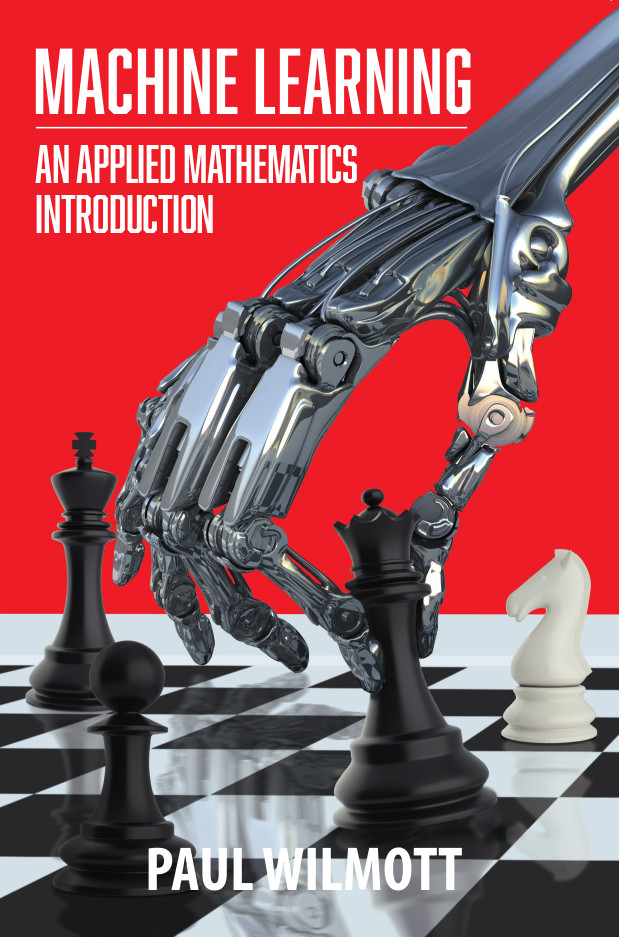Machine Learning: An Applied Mathematics Introduction covers the essential mathematics behind all of the following topics
- K Nearest Neighbours
- K Means Clustering
- Naïve Bayes Classifier
- Regression Methods
- Support Vector Machines
- Self-Organizing Maps
- Decision Trees
- Neural Networks
- Reinforcement Learning

The book includes many real-world examples from a variety of fields including finance (volatility modelling), economics (interest rates, inflation and GDP), politics (classifying politicians according to their voting records, and using speeches to determine whether a politician is left or right wing), biology (recognising flower varieties, and using heights and weights of adults to determine gender), sociology (classifying locations according to crime statistics), and gambling (fruit machines and Blackjack).
CONTENTS
Prologue xi
1 Introduction 1
1.1 The Topic At Hand 2
1.2 Learning Is Key 3
1.3 A Little Bit Of History 4
1.4 Key Methodologies Covered In This Book 6
1.5 Classical Mathematical Modelling 9
1.6 Machine Learning Is Different 11
1.7 Simplicity Leading To Complexity 12
2 General Issues 17
2.1 Jargon And Notation 17
2.2 Scaling 18
2.3 Measuring Distances 19
2.4 Curse Of Dimensionality 20
2.5 Principal Components Analysis 21
2.6 Maximum Likelihood Estimation 21
2.7 Confusion Matrix 26
2.8 Cost Functions 28
2.9 Gradient Descent 33
2.10 Training, Testing And Validation 35
2.11 Bias And Variance 37
2.12 Lagrange Multipliers 43
2.13 Multiple Classes 45
2.14 Information Theory And Entropy 46
2.15 Natural Language Processing 49
2.16 Bayes Theorem 51
2.17 What Follows 52
3 K Nearest Neighbours 55
3.1 Executive Summary 55
3.2 What Is It Used For? 55
3.3 How It Works 56
3.4 The Algorithm 58
3.5 Problems With KNN 58
3.6 Example: Heights and weights 59
3.7 Regression 62
4 K Means Clustering 65
4.1 Executive Summary 65
4.2 What Is It Used For? 65
4.3 What Does K Means Clustering Do? 67
4.4 Scree Plots 71
4.5 Example: Crime in England, a 13-dimensional example 72
4.6 Example: Volatility 74
4.7 Example: Interest rates and inflation 76
4.8 Example: Interest rates, inflation and GDP growth 79
4.9 A Few Comments 80
5 Naive Bayes Classifier 83
5.1 Executive Summary 83
5.2 What Is It Used For? 83
5.3 Using Bayes Theorem 84
5.4 Application Of NBC 84
5.5 In Symbols 85
5.6 Example: Political speeches 86
6 Regression Methods 91
6.1 Executive Summary 91
6.2 What Is It Used For? 91
6.3 Linear Regression In Many Dimensions 92
6.4 Logistic Regression 93
6.5 Example: Political speeches again 95
6.6 Other Regression Methods 96
7 Support Vector Machines 99
7.1 Executive Summary 99
7.2 What Is It Used For? 99
7.3 Hard Margins 100
7.4 Example: Irises 102
7.5 Lagrange Multiplier Version 104
7.6 Soft Margins 106
7.7 Kernel Trick 107
8 Self-Organizing Maps 113
8.1 Executive Summary 113
8.2 What Is It Used For? 113
8.3 The Method 114
8.4 The Learning Algorithm 116
8.5 Example: Grouping shares 119
8.6 Example: Voting in the House of Commons 124
9 Decision Trees 127
9.1 Executive Summary 127
9.2 What Is It Used For? 127
9.3 Example: Magazine subscription 129
9.4 Entropy 134
9.5 Overfitting And Stopping Rules 137
9.6 Pruning 137
9.7 Numerical Features 138
9.8 Regression 139
9.9 Looking Ahead 144
9.10 Bagging And Random Forests 145
10 Neural Networks 147
10.1 Executive Summary 147
10.2 What Is It Used For? 147
10.3 A Very Simple Network 147
10.4 Universal Approximation Theorem 149
10.5 An Even Simpler Network 150
10.6 The Mathematical Manipulations In Detail 151
10.7 Common Activation Functions 154
10.8 The Goal 156
10.9 Example: Approximating a function 157
10.10 Cost Function 158
10.11 Backpropagation 159
10.12 Example: Character recognition 162
10.13 Training And Testing 164
10.14 More Architectures 168
10.15 Deep Learning 170
11 Reinforcement Learning 173
11.1 Executive Summary 173
11.2 What Is It Used For? 173
11.3 Going Offroad In Your Lamborghini 400 GT 174
11.4 Jargon 175
11.5 A First Look At Blackjack 176
11.6 The Classical MDP Approach In Noughts & Crosses 177
11.7 More Jargon 179
11.8 Example: The multi-armed bandit 180
11.9 Getting More Sophisticated 1: Known environment 183
11.10 Example: A maze 186
11.11 Value Notation 190
11.12 The Bellman Equations 192
11.13 Optimal Policy 193
11.14 The Role Of Probability 194
11.15 Getting More Sophisticated 2: Model free 195
11.16 Monte Carlo Policy Evaluation 195
11.17 Temporal Difference Learning 198
11.18 Pros And Cons: MC v TD 200
11.19 Finding The Optimal Policy 200
11.20 Sarsa 201
11.21 Q Learning 202
11.22 Example: Blackjack 204
11.23 Large State Spaces 215
Datasets 217
Epilogue 221
Index 223